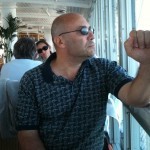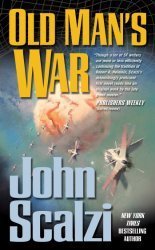Massimo Marino's Blog: The Ramblings and the Rumblings, page 13
January 17, 2015
After the Siege – Cory Doctorow
 Introduction to After the Siege by the Author, Cory Doctorow:
Introduction to After the Siege by the Author, Cory Doctorow:
“Listeners to my podcast heard me read this story, “After the Siege,” as it was written, shortly after returning home from a family trip to St Petersburg. My grandmother was born there, back when it was Leningrad, and she lived through the Siege of Leningrad as a little girl. She’d never talked to us about those years, but then, walking through Petersburg, she opened up and the stories came pouring out, stories that scared and appalled me. “After the Siege” is a science fictional re-telling of those stories, with much artistic license.”
Science fiction has a long tradition of social commitment, in the fifties this issue reached its peak with the sociological works trend but stories that questioned about the society and its future have always been written, both before and after that period.
Thus, it’s not at all surprising that Cory Doctorow, as the representative of the flourishing Canadian school of science fiction, but also a journalist and a successful blogger, had his heart close to this theme, and not just for family history.
After the Siege is a violent story which tells how to the “power in charge,” any means is permissible in order to crush the rebellion against a system that does not tolerate any dissent.
is a violent story which tells how to the “power in charge,” any means is permissible in order to crush the rebellion against a system that does not tolerate any dissent.
Life is a constant surprise for Valentine, a thirteen years old girl. To her eyes new wonders continue to appear, life seems to smile at her, and the future is full of promise and happiness.
But all this has an abrupt end when the child is experiencing the last wonderful news, a movie theatre destined to become the grave for many of his little friends.
An enemy army attacks her town, and Valentine soon experiences how life can become violent, as resources become scarce under the tight siege of the enemy troops.
Her mother and her father leave for the front, and the child remains alone with her brother, suffering food shortages and while a terrible disease that turns people into zombies plague the city.
Immediately after the death of her father, Valentine meets a man who seems to be spared from the miseries of war, a mysterious character called “The Wizard”, which still has a fully functional “printer”.
Miraculous nanotechnology devices were the cause of the war, the enemy wants to prevent their free use, and considers the city a den of criminals and thieves, to be eradicated without mercy.
Valentine can not figure out who the Wizard is and what is he after, at first she suspect him to be a spy, then she discovers he is a war reporter, and becomes angry at his refusal to help the city in any factual way.
The history of Valentine and the Wizard intertwine several times, while the siege is becoming harsher and harsher, and fighters resist but pay a terrible price, but no one knows for sure whether the city will be able to maintain its independence or will be crushed in the mud and the blood of its citizens.
Valentine is a young girl whose life is interrupted by the nightmare, which takes the shape of an army decided to end the free use of a powerful technology. The city, located somewhere in the world, perhaps in Eastern Europe, has already fought a war to throw off the yoke of imposed economic sanctions, but this time the test will be even tougher.
Needless to say, the author’s sympathies go to Valentine and the inhabitants of the city, whose struggle is seen as a heroic resistance against an oppressor, but Doctorow does not fall into the trap of wanting to prove a point.
The Canadian writer writes a damn good prose, and manages to captivate the reader from the first pages of his works; Valentine’s descent into the nightmare, and her stubborn will to survive are narrated in a masterful way.
Despite this is a hard novel to read, and sometimes ruthless, it closes with an optimistic note: Doctorow seems to be telling us that despite everything there is hope even when everything tells us there’s no way out.
This optimism, however, is not entirely convincing and the ending seems a bit rushed and might constitute, for some, the limit of a novel that still will leave its mark on the readers.
Massimo Marino is a scientist envisioning science fiction. He spent years at CERN and The Lawrence Berkeley Lab followed by lead positions with Apple, Inc. and the World Economic Forum. He is also co-founder of “Squares on Blue”, a Big Data Analytics service company.
Massimo currently lives in France and crosses the border with Switzerland multiple times daily, although he is no smuggler.
As a scientist writing science fiction, he went from smashing particles at accelerators at SLAC and CERN to smashing words on a computer screen.
He’s the author of multi-awarded Daimones Trilogy.
His novels have received the Seal of Excellency from both AwesomeIndies.net and IndiePENdents.org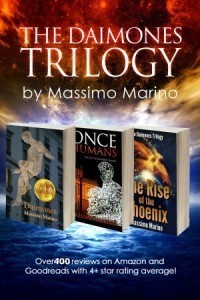
• 2012 PRG Reviewer’s Choice Award Winner in Science Fiction
• 2013 Hall of Fame – Best in Science Fiction, Quality Reads UK Book Club
• 2013 PRG Reviewer’s Choice Award Winner in Science Fiction Series
• 2014 Finalist – Science Fiction – Indie Excellence Awards L.A.
• 2014 Award Winner – Science Fiction Honorable Mention – Readers’ Favorite Annual Awards
His novels are available from Amazon, Barnes & Noble (Nook), iTunes Apple Store, and many other retailers around the world.
Join his mailing list for new releases, or follow him on Facebook, Google+, and Twitter.
The post After the Siege – Cory Doctorow appeared first on § Author Massimo Marino.
January 13, 2015
The Fountains of Paradise – Arthur C. Clarke
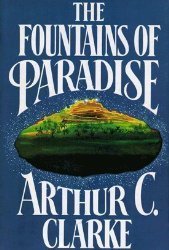
 The Fountains of Paradise
The Fountains of Paradise takes place in a scenario typical of many novels from Clarke.
takes place in a scenario typical of many novels from Clarke.
We are about a hundred years in the future, in a solar system that begins to be colonized in a massive way, a situation, if not likely, at least possible. The novel has been published in 1979 and Clarke envisions a futuristic technology project that is no more science fiction: today, studies are conducted to turn that science fiction crazy idea into the reality of our present days. And it is not the first time it happens with envisioned futuristic technologies that ‘see’ the light first on the pages of a science fiction story.
The vision of what lies ahead is optimistic: according to Clarke in the future many current problems will be solved and the society will be more stable, but difficulties are never lacking, especially for those who want to break into new ground.
Taprobane is a small island full of history, often bloody, living a finally quiet present, bathed in light and in the heat of the equator.
The end of peace arrives in the unlikely role of an engineer, Vannevar Morgan, the bold and brilliant designer of the bridge across the Straits of Gibraltar, and it is the position of the island that makes it the candidate (or condemn it) to become the star of an extraordinary project.
Morgan is a visionary, capable of dizzying advances, but for what he has in mind words like bold and extraordinary are insufficient: the designer has in mind to build an elevator to the stars.
A space station in a geo-synchronous orbit, anchored to the ground with a long cable twenty-five thousand km, would lift to orbit heavy loads in a fraction of the cost and without harming the environment.
Unfortunately, only one point on Earth has the ideal characteristics for a safe anchorage, and right on the mountain chosen by Morgan has lived for centuries a community of Buddhist monks.
Even in a hyper-modern world, religion is a powerful force, and a ruling by the World Court prohibits building the Space Elevator anchored around the monastery.
Bitter defeat for Morgan, but it does not make him stop fighting, though now only a miracle could reverse the situation and allow him to realize his dream.
Clarke favors novels set in a not too distant future, when humanity has colonies and outposts on satellites and planets in the solar system. A great initial idea (the orbit elevator), developed with scientific rigor, a pinch of twists and maximum attention to the plot and logical development of the story, with these ingredients the English writer has packed several novels, almost all great. The Fountains of Paradise
The Fountains of Paradise is ridden with numerous difficulties and surprises, and a solo mission. The novel has a subtle charm, almost inexplicable, the only well developed character is the engineer, Morgan, the pace is anything but devilish and lovers of stories with plenty of action may be disappointed, but often it is not the case with Clarke.
is ridden with numerous difficulties and surprises, and a solo mission. The novel has a subtle charm, almost inexplicable, the only well developed character is the engineer, Morgan, the pace is anything but devilish and lovers of stories with plenty of action may be disappointed, but often it is not the case with Clarke.
The story lives on the idea of the orbit elevator and its technological descriptions. Clarke is a master at explaining technologies that nobody has ever seen, and inserts them into the story in a natural and imperceptible way.
Another element of interest are the references to the past and the contrast between the technological requirements and religion, a conflict that sees Clarke on the side of science.
The paradoxical way in which he solves the standoff between the Buddhist monastery and Morgan is the irrationality of religion, which is condemned by itself.
The novel has extraordinary descriptions of the landscapes and artistic treasures of Taprobane, and here Clarke plays at home: the island is modeled on a well-known one, since the writer has lived for more than half a century in Ceylon, the current Sry Lanka, and it’s the inspiration for Taprobane.
Ultimately, one of the best novels of one of the greatest science fiction writers.
Massimo Marino is a scientist envisioning science fiction. He spent years at CERN and The Lawrence Berkeley Lab followed by lead positions with Apple, Inc. and the World Economic Forum. He is also co-founder of “Squares on Blue”, a Big Data Analytics service company.
Massimo currently lives in France and crosses the border with Switzerland multiple times daily, although he is no smuggler.
As a scientist writing science fiction, he went from smashing particles at accelerators at SLAC and CERN to smashing words on a computer screen.
He’s the author of multi-awarded Daimones Trilogy.
His novels have received the Seal of Excellency from both AwesomeIndies.net and IndiePENdents.org
• 2012 PRG Reviewer’s Choice Award Winner in Science Fiction
• 2013 Hall of Fame – Best in Science Fiction, Quality Reads UK Book Club
• 2013 PRG Reviewer’s Choice Award Winner in Science Fiction Series
• 2014 Finalist – Science Fiction – Indie Excellence Awards L.A.
• 2014 Award Winner – Science Fiction Honorable Mention – Readers’ Favorite Annual Awards
His novels are available from Amazon, Barnes & Noble (Nook), iTunes Apple Store, and many other retailers around the world.
Join his mailing list for new releases, or follow him on Facebook, Google+, and Twitter.
The post The Fountains of Paradise – Arthur C. Clarke appeared first on § Author Massimo Marino.
January 10, 2015
Martians, Go Home – Fredric Brown
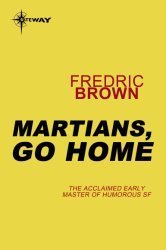
 Probably, it is the fault of Herbert George Wells. If this noble father of science fiction chose Venus or Titan, or a distant star as a base for his War of the Worlds
Probably, it is the fault of Herbert George Wells. If this noble father of science fiction chose Venus or Titan, or a distant star as a base for his War of the Worlds things would have gone differently. Sure, there have been invasions later arrived from other remote depths of space, but for our collective unconscious the enemy planet, the seat of evil intelligences hostile to us, the home of the little green men, remains Mars.
things would have gone differently. Sure, there have been invasions later arrived from other remote depths of space, but for our collective unconscious the enemy planet, the seat of evil intelligences hostile to us, the home of the little green men, remains Mars.
In the decades, attacks of all kinds came from the red planet, subtle, direct, even mystical; sometimes humanity has survived, other times it’s been defeated, sometimes the situation has resulted in a draw. The case of the most blatant and disrespectful of the many invasions came from the red planet, the one told by Fredric Brown in Martians, Go Home .
.
No spaceships, no death rays flashing in the night, no burning cities or crowds stampede and desperate attempts to repel the thin but deadly Martian tripods, this time. Unfortunately, even no bacillus or song of the fifties are there to save our poor land from an invasion that will take us to the brink (and beyond) of a nervous breakdown.
Luke Devereaux is in trouble, he has just separated and can not even begin the science fiction novel whose advance was received months before. To solve at least the second problem, Luke retired in a solitary, isolated shed in the arid Southern California. In order to get inspiration, he has even limited his daily ration to only five glasses of whiskey.
After days of torment, the glimmer of a good idea comes to mind of the writer, something about the Martians, but at that moment someone knocks on the door. Annoyed and bewildered, Luke opens the door and faces, or rather his knees meet with a green little man who claims to be from a planet with two moons.
And this is the beginning of a nightmare not only for poor Luke, but for all humanity. The invasion of Martians is total and absolute, no one is able to kill them or drive them out, there are no safe places or barriers impassable for these troublesome presences. Irreverent and meddlesome, Martians seem to enjoy in embarrassing humans, revealing small and big secrets, or appearing at inopportune moments, like the wedding night.
While the nerves and the economy of humanity slowly collapses, many try to find a way to free the land from the uncomfortable presence of the meddling greenies. Someone will succeed, or are the Martians really intended to be a constant nuisance, and in this case what can humanity do to resist before slipping into madness?
Science fiction is a genre where humor is difficult, it takes guts to take the risk of crossing the fine line with the ridiculous, perhaps that’s why there aren’t so many works with this particular stamp. Fredrick Brown can afford to joke with the very serious issue of an alien invasion, and even describe them as little green men, without any fear. These are these Martian, childish, nosy, wordy, cheeky, mischievous and intrusive: a real scourge.
The hypotheses on their true nature multiply, but not one seems perfect, even the many ways tried to resist their nagging presence fail, attempts to communicate with them are bankrupt as those to ignore them. Disgusted by human habits, but at the same time curious to know them thoroughly, the little green men of Brown can make us regret the huge tripods and their death rays of H. G. Wells. At least they could just kill you, a brief moment of pain, and it was all over.
Master of the story, especially the short ones, Brown succeeds in his few novels to hit the target. Martians, Go Home is funny and ironic, wrote on the wire of the desecration of a major topos of science fiction.
The finish is beautiful, leaves doubts about what really happened, as if Brown liked to leave to the reader the choice … and between science, philosophy, and African magic, very nearly the last one seems preferable.
Massimo Marino is a scientist envisioning science fiction. He spent years at CERN and The Lawrence Berkeley Lab followed by lead positions with Apple, Inc. and the World Economic Forum. He is also co-founder of “Squares on Blue”, a Big Data Analytics service company.
Massimo currently lives in France and crosses the border with Switzerland multiple times daily, although he is no smuggler.
As a scientist writing science fiction, he went from smashing particles at accelerators at SLAC and CERN to smashing words on a computer screen.
He’s the author of multi-awarded Daimones Trilogy.
His novels have received the Seal of Excellency from both AwesomeIndies.net and IndiePENdents.org
• 2012 PRG Reviewer’s Choice Award Winner in Science Fiction
• 2013 Hall of Fame – Best in Science Fiction, Quality Reads UK Book Club
• 2013 PRG Reviewer’s Choice Award Winner in Science Fiction Series
• 2014 Finalist – Science Fiction – Indie Excellence Awards L.A.
• 2014 Award Winner – Science Fiction Honorable Mention – Readers’ Favorite Annual Awards
His novels are available from Amazon, Barnes & Noble (Nook), iTunes Apple Store, and many other retailers around the world.
Join his mailing list for new releases, or follow him on Facebook, Google+, and Twitter.
The post Martians, Go Home – Fredric Brown appeared first on § Author Massimo Marino.
January 7, 2015
Creating Characters
 Alice Walker said that while she was writing The Color Purple
Alice Walker said that while she was writing The Color Purple her characters gave her back talk about how they should or should not act. I experience that with my virtual companions, too, and I’m sure you do the same. So, how do we as writers develop believable characters? We can’t always wait until one sits on our couch and rebels by saying, “I don’t care how you write it, I ain’t doin’ it, no way, no how.”
her characters gave her back talk about how they should or should not act. I experience that with my virtual companions, too, and I’m sure you do the same. So, how do we as writers develop believable characters? We can’t always wait until one sits on our couch and rebels by saying, “I don’t care how you write it, I ain’t doin’ it, no way, no how.”
Some writers create complete biographies for every one of their characters: birth date, siblings, report cards, first sexual experience, wardrobe, job history, height, weight, medical history, birthmarks. Only when they know more about the character than the character would know about him or herself, do they set pen to paper or finger to keyboard. Others wing it letting their character develop with the story. However you develop the character completely or partially, they do have a life beyond your use of them.
Writer Kim Edwards says, “For a character to be convincing, what’s on the page must somehow evoke knowledge that extends beyond what’s strictly visible.” It’s like when we meet people at a party. This may be our only contact with them, but they have existed before we meet them, and they will exist after they leave.
We can define characters in many ways:
Clothing – There’s a photo of Richard Nixon walking on the beach wearing a suit and tie. Anyone else would be in a bathing suit or at least jeans and a sweater. I suspected Nixon slept in his suit and woke up with his trousers creased.
Place – A man working on a farm will have a different character from a man stuck in a corporate cubby.
Time – If your story is about a sixties hippie in 1969, he would be reacting to the War. If he is still a hippie in the 90s, he might have sparse gray hair pulled back in a ponytail. If he’d gone corporate, he might be in a three-piece suit and drive a Subaru. Today he would be a frail old man sharing memories with mocking or adoring teenagers.
Speech can reveal education and age, and sometimes it can show even more. Think of Laertes’s speech in Hamlet: “Neither a lender or a borrower be…” it shows him as a pompous man much more than a wise man. The contrast between his character and words is a classic. Speech needs to be education specific. A person with a doctorate might use slang, but a person with an eighth grade education would probably not give a lecture on quantum mechanics. Slang also needs to be time specific. “Stoned gas” would work for the 60s and “Been there, done that” for the 90s.
Actions – This is where your character develops and become real. Through what they do and how they react to events in the story their inner ‘self’ shows, and that’s when your characters will refuse to act as you would like, or do unexpected things: their actions are “in-character,” and the more you ‘feel’ them, the more they’ll be credible and real to the reader. Sometimes, startling events happen, situations that would push anyone to the border with madness, and your character will change, act in unexpected ways, ‘out-of-character,’ for so to speak, but the discerning reader will feel the struggle and ponder: “My goodness, how would I have reacted if it had happened to me?”
Characters can be created without a specific effort to create a portrait and details can be added in a seemingly casual way. Let’s show an example with fictional Karen:
Within seconds of walking into her house, Karen tore off her navy blue suit, kicked off her heels, and shook out her hair. As she padded into her bedroom, she glanced around. A pile of dirty clothes stood in the corner. She sniffed the sweatpants she’d worn the day before. Good enough for a quiet night at home.
A whole weekend alone awaited her. Yes. Her colleagues at the law firm planned to hit the pub for yet another Happy Hour, but she excused herself. She’d pleaded a previous engagement, not wanting to tell anyone that her fondest dream was to do the laundry, put on the CD she’d bought at lunch, and let Bach’s harpsichord provide a background as she attacked the canvas waiting for her. Two whole days without having to listen to any husband trying to do his wife out of her share of their joint assets.
From these details what do we know about Karen’s character? Karen is working as a lawyer. She needs to escape from her work. She lets her clothes pile up, so she isn’t a total neatnik, but she does do laundry. She likes classical music. She probably lives alone and likes it. She doesn’t reveal herself to her coworkers.
Massimo Marino is a scientist envisioning science fiction. He spent years at CERN and The Lawrence Berkeley Lab followed by lead positions with Apple, Inc. and the World Economic Forum. He is also co-founder of “Squares on Blue”, a Big Data Analytics service company.
Massimo currently lives in France and crosses the border with Switzerland multiple times daily, although he is no smuggler.
As a scientist writing science fiction, he went from smashing particles at accelerators at SLAC and CERN to smashing words on a computer screen.
He’s the author of multi-awarded Daimones Trilogy.
His novels have received the Seal of Excellency from both AwesomeIndies.net and IndiePENdents.org
• 2012 PRG Reviewer’s Choice Award Winner in Science Fiction
• 2013 Hall of Fame – Best in Science Fiction, Quality Reads UK Book Club
• 2013 PRG Reviewer’s Choice Award Winner in Science Fiction Series
• 2014 Finalist – Science Fiction – Indie Excellence Awards L.A.
• 2014 Award Winner – Science Fiction Honorable Mention – Readers’ Favorite Annual Awards
His novels are available from Amazon, Barnes & Noble (Nook), iTunes Apple Store, and many other retailers around the world.
Join his mailing list for new releases, or follow him on Facebook, Google+, and Twitter.
The post Creating Characters appeared first on § Author Massimo Marino.
January 5, 2015
Dying of the Light – George R. R. Martin
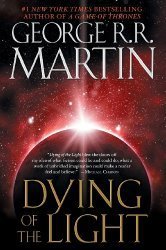
 I believe not many know of this first novel by George RR Martin, an unknown author destined for a bright career. Dying of the light is a work that has been fairly successful, resulting finalist both at the Hugo and at the British Fantasy Awards.
I believe not many know of this first novel by George RR Martin, an unknown author destined for a bright career. Dying of the light is a work that has been fairly successful, resulting finalist both at the Hugo and at the British Fantasy Awards.
It is an ambitious and complex story that reveals the traits of the future writer of races and clans, a story set in an unforgettable world, Worlorn, a wanderer in the deep space, without light, cold and bleak, at least until the Wheel of Fire, the most amazing star system ever discovered, sheds light upon it for the first time.
A short, intense summer heats up Worlorn, to become the site of the Festival of the Margins, 14 races and planets, and to be visited by millions of people, at least until the darkness will return to dominate.
Sometimes the past comes back and overwhelms the safety of a whole life, bursting into the daily reality in strange ways: the lace that captures Dirk’t Larien is a tiny jewel. A gem of the soul, a pledge that led him to embark on a journey into the unknown, to his old love Gwen, to the planet Worlorn, a world that is about to slip back into a gloomy winter. Once arrived on the planet, Dirk collides with an unexpected reality, Gwen does not seem at all pleased to see him. Worse yet, the woman is permanently linked to Jaan Vikary and his “teyn” Garse, two noble High Kavalan, a world dominated by clan and rigid laws of honor, one of the most retrograde planets in the galaxy. So why did she send him their ancient pledge of love, knowing that he would come to her rescue?
As the planet moves away from Fat Satan, the giant red star that has given it an ephemeral but extraordinarily fruitful summer, Dirk will face a difficult situation, caught between Gwen who seems not to love him anymore, and the ferocity of some noble High Kalavan, for which he is just a phony, a prey to knock down. Dirk will have to take over his life and bring out resources he did not suspect the existence if he wants to get out alive from the complex situation in which he was dragged into by a little gem.
Dying of the Light had a different title at first, perhaps a bit more evocative: After the dark. Indeed, the darkness seems to dominate the story of Dirk and Gwen, their meeting on Worlon is the result of a deception, and the beginning of a slow descent into darkness. An inexorable flow of events will lead both to confront enormous dangers and with the reality of their consciences.
Ambitious and complex, the first novel by Martin entails some issues that the writer will face throughout his corpus of books, even if the narrative mechanism is not as smooth as in his later works. Some small imperfections do not ruin, though, the overall goodness of the complex plot. “Dying of the Light” is the conclusion of a long narrative cycle of stories from Martin. For this, there is a long dictionary of names and places. As always in these cases, the writer remains prisoner of a number of facts which must be taken into account and that encumbers the story.
This said, in this adventurous novel, the epic, the grandiose scenarios are accompanied by a psychological, careful construction of the characters. As in many works of Martin, there are no “good” and “bad” absolutes: the nobles Kalavaniani can be fierce and ruthless but still follow their code of honor; Dirk and Gwen should be free spirits, but their behavior is not free from cowardice and meanness.
The scenario is dominated by Worlorn, the lone wanderer planet, illuminated for a moment by the most extraordinary of stellar systems. The worlds of the Margin have sown with multiple forms of life during its approach to Fat Satan red star, they have built fourteen cities, and the headquarters of the fabulous Festival of Margins. The story takes place at the end of the festival, when few people remain to populate a planet that gets increasingly cold, and has started on a road to the end of which there is only darkness. Regrets and melancholy dominate the novel.
It’s a good book, and the advice is to read first thing the short glossary which explains many of the terms used in the novel and gives a vision of the worlds that populate the galaxy.
For all those who loved the science fiction writer Martin, his first novel is a must read.
The post Dying of the Light – George R. R. Martin appeared first on § Author Massimo Marino.
January 1, 2015
Paradises Lost – Ursula Le Guin
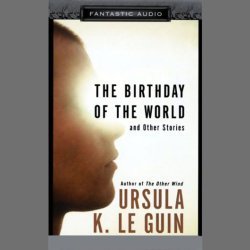
 If you were ever to embark on the Generation ship, headed toward a distant solar system’s small world, you should know that often things are bound to end badly.
If you were ever to embark on the Generation ship, headed toward a distant solar system’s small world, you should know that often things are bound to end badly.
Think about those who would experience the story of countless generations who live in a protected environment in the deep outer space where nothing ever is supposed to happen.
Ursula K. Le Guin engages with this fascinating subject, and does it in her own way with Paradises Lost, a novella that is part of a collection of short stories where all possible precautions have been put in place for a good ending.
Let’s see if it really worked. The Discovery is the zenith of human science and technology prowesses, a giant made of steel, intended to cross interstellar space and to bring a small group of settlers on another world. The human cargo of the ship is the culmination of social sciences and human medicine. No bacteria or pathogenic viruses, no bugs or wild beasts, no genetic disease made into the perfectly organized ship. An egalitarian society, multiracial and complex, where there are conflicts but where life flows smoothly.
The protagonists of the story are two settlers of the fifth generation: 5-Nova Luis and 5-Hsing Liu, who have known each other before the ceremony of clothing, during which the children wear clothes for the first time. For our two protagonists, life is a continuous discovery; certainly not everything is perfect, and the acts of violence are rare, but they have not disappeared aboard and there is always the threat of psychological problems.
In the past, the syndrome of somatic depression and a series of miscarriages had endangered the stability of the population, and now the tactile sensitivity syndrome remains without a cure. However, the real problem comes in an unexpected form, a new religion that spreads among the settlers.
Founded by 1-Kim Terry, the religion of Angels preaches the journey as being the only goal, the spacecraft as paradise, and is obviously contrary to any descend on an unknown planet and any colonization plans. Luis and Hsing do not care much of the Angels, and what to do upon arrival on the planet intended to be colonized will be a problem to be addressed in a few decades, but then Hsing discovers that an unexpected acceleration has shortened the journey of more than forty years. With the arrival to the New Earth now being so close, the divide between the Angels and the others is evident in all its drama.
Few science fiction writers know how to build fantasy and futuristic societies like Le Guin, and in this novella the creativity of the writer emerges strongly. The inhabitants of the Discovery live in a kind of utopia whose description is the strong point of this story. Their social structure was studied at the table to ensure the stability necessary to achieve the goal of the mission, rationality and science are the driving forces of this isolated microcosm, perfect and enjoyable, but this perfection is the weak point of the community: not everyone is willing to leave a safe and secure world, a perfect society, to face the unknown. This raises the creed of the Angels, the followers of Bliss, who see not the ship as a tool to reach another planet but as the end, the heaven that loves them and protects them from any external danger.
In this novella, the contrast between reason/science and religion is the great underlying theme of Paradises Lost, Ursula Le Guin answers are neither simple nor obvious. Le Guin has a clear opinion that is perceivable only by reading carefully.
The society living aboard the Discovery proves to still be able to find peaceful solutions to face deep internal divisions, and perhaps this is the limit of the novella, which might displease those who love adventures at the edge of the cliff of doom. Those who prefer the social, ethical and psychological issues dear to Le Guin, who takes off from a narrow field of conceptualizations to develop universal themes and questions, will find in this novella a not to be missed treasure.
The post Paradises Lost – Ursula Le Guin appeared first on § Author Massimo Marino.
December 29, 2014
Rogue in Space – Frederic Brown
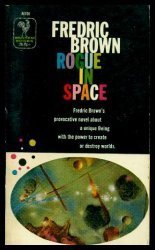
 Derived from the union of two short stories written in the forties, the novel narrates the exploits of a hero different from those in vogue at the time.
Derived from the union of two short stories written in the forties, the novel narrates the exploits of a hero different from those in vogue at the time.
Craig is the product of a series of unfortunate events that led him to become a ruthless criminal and to hate all women. His hatred stems from the abandonment by his wife after an accident that cost him a hand and his work, his fierceness by the need to survive in a brutal society.
Two hundred years in the future, humanity has colonized much of the solar system, but corruption and decadence reign, a democratic facade hides ruthless power struggles. In this universe, Craig is an unscrupulous man, always balanced on the razor’s edge of life, until he is arrested for drug possession, someone set him up and now he awaits death or a brainwash.
Unexpected help comes from Judge Oliver, who offers to help him in exchange for a job that’s not completely legal. With no way out, Craig accepts. Finally sentenced to be brainwashed, Craig is not “cleaned” of his past. The beautiful wife of Oliver, Judeth, only pretends to perform the surgery, and leaves Craig’s mind intact. Once a free man, he pays his debt with Judge Oliver stealing a disintegrator device heavily guarded in Menlo, the Martian fortress of Eisen, a brilliant and eccentric scientist. A difficult task that Craig carries out with ease, the device is able to reduce the matter to the state of neutronium, but the process is extremely slow, which apparently makes the device of no real practical use.
However, Oliver thinks he can use the disintegrator and reveals that he wants to experiment it on a small asteroid.
The book’s credibility is not enhanced by Brown’s often-poor grasp of science, and it is a sci-fi novel of the 50s that presents the future as the fifties society with rockets, space travels, and planet colonization. Besides these limitations, it is well written and it flows easily, but its merit lies more on the fact that it presents one of the first anti-heroes of science fiction, if not the very first one. Craig is a figure that emerges with power, anger smoldering devours him and makes him intolerant and hostile toward all rules and the company of others, with a few exceptions. His hatred of women and their company is absolute. Oliver is a cunning politician, respectable in appearance, but actually power-hungry and willing to do anything to get it. The world where the characters evolve is corrupt and rotten, money is the only yardstick and allows to get everything and open all doors … and unfortunately this sounds even too familiar in our society.
A passable read.
The post Rogue in Space – Frederic Brown appeared first on § Author Massimo Marino.
December 27, 2014
Redshirts – John Scalzi
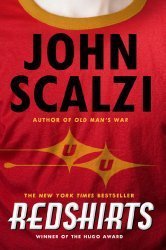
 Redshirts, a peculiar space adventure.
Redshirts, a peculiar space adventure.
When Andrew Dahl takes service with a sense of bride aboard the flagship Intrepid of the Universal Union, he soon realizes that things are not as they should on board. First of all, the death rate among the low ranks is scary, even when taking into account that the missions of the Intrepid are dangerous the losses are really too high. But there are other things that do not add up: how is it possible that Lieutenant Kerensky is injured, infected, beaten and hit virtually on every mission but always gets away and reappears again ready for the next mission? And what’s behind all those strange investigations, requested with very short notices, and which are always carried out brilliantly although in such a chaotic and incomprehensible way?
Apparently the key to everything is in the hands of a crew member who is hiding from everyone, hidden in the bowels of the ship, and finding him will become a matter of life or death. Literally.
Difficult to classify and label a work as Redshirt. We are confronted with a novel with three “codas,” as its own descriptions says, or is it an anthology with a short novel and three stories?
John Scalzi has packed a very particular product, in spite of the trite narrative plot chunks—the spacecraft launched in deep space exploration (Star Trek and red uniforms anyone?)—the narrative does follow innovative paths. The mystery and suspense are no longer linked to alien creatures or dangers of mysterious planets, but to the particular conditions existing on board the Intrepid. Is there is a secret plot among the senior officers, or some strange force or entity at work or is it just an incredible bad luck? Or could the truth be even more shocking?
A fun novel (an anthology?) to read, written with verve and lightness. In the first part, we witness the tactics that are put in place to prevent the deadly planetary missions, the encounters with aliens, and the relationships between the crew members mingle with the investigation. In the second, the shocking truth is revealed. And at this point we need to find how we can avoid to become the next name on the list of the men in redshirts who died while carrying out their duty.
A truly original, which shows that the Science Fiction knows how to laugh at herself.
The post Redshirts – John Scalzi appeared first on § Author Massimo Marino.
December 24, 2014
Old Man’s War – John Scalzi
Life begins at 75 years. At least that’s what John Perry—who has reached this age—hopes.
John Scalzi supposes that all things human-physiology will have limits in the future, even after the colonization of space. Even more so, precisely in space there could be new challenges to human’s limitations.
In his future world, at 65 the “elders” sign a contract to be enrolled at the expiry of the prophetic 75 years of age as foot soldiers of the Colonial Defense Forces.
So did John and his wife. John is not giving up his chance to discover how is it possible that worn out bodies and, in some cases, patients may be allowed to serve in the military for at least another ten years, at the end of which soldiers are expected to enter into a space colony, to live a new life.
Yes, but what kind of new life can begin at 85 years?
The bodies are simply thrown away and the very essence of existence, the alleged soul, is transferred to another body as a new software installation. A young body, cloned from the original genetic material, but enhanced in many characteristics to make it a super-human, better, a super-soldier.
Despite the experience of a lifetime, John is not prepared not only to use his formidable new body, but also to find that “out there”, Space is not a lonely place. Breeds of all types are struggling to survive. Human experiences are not applicable to the behavior of aliens. One of the first lessons that John learns is that there’s a war with a bare minimum chance to survive, so although his new body can look amazing in comparison to normal human beings, against the aliens is just enough. For the rest, he has to learn to get along, and fast. Battle after battle, experience after experience, John will make a rapid career, being involved in clashes and crucial moments of the war of the human race to survive in space.
War novels are not than interesting if they speak of the many soldiers, the majority, who die in the first clash, or those who were in the second row during the clashes. No, the story needs to tell about the man that, like it or not, made the difference, even if through amazing twists of luck. Some suspicion about the extraordinary good fortune of John will also reach his superiors as he will be the only survivor of a battle with an alien race that seems equipped with technologies that can predict the moves of opponents. But it is precisely in that clash, which John has survived by a miracle, that he runs into an even bigger mystery. Who is that soldier of The Ghost Brigades who seems so resemble his late wife?
who seems so resemble his late wife?
Going into the final match of Scalzi’s nimble prose we are quickly leads to the resolution of this and many other mysteries, still leaving large gashes and glimpses of a complex plot so full of ideas that they are overflowing from the novel. The secret of the Ghost Brigade is just one of many.
One cannot but wonder about how the settlers will live as veterans from military service. Are those 85 year old, war veterans in young bodies, destined to live peacefully and emotionally more experiences for at least hundred more years? It is another portion of universe that deserves to be explored.
As for the militarism of the novel, Scalzi matches that American pragmatism that justifies the possession of weapons in the house and that is transverse to any political conviction. The space is like the Wild West, it is mandatory to kill in order to avoid being killed. It’s live and let die.
The Army institution described in the novel seems immune to stains and corruptions—a progress from present days—but not to errors of judgment—a continuity of present days. There is no glorification of military values, but only acceptance of their necessity given the circumstances. It is then the same “lesson” that was the primal source of inspiration for another novel, Starship Troopers of Robert Heinlein, which Scalzi pays homage to openly and slavishly, although it remixes those elements adding his own themes and ideas. An operation that happens often in genre, but in this case with good results.
of Robert Heinlein, which Scalzi pays homage to openly and slavishly, although it remixes those elements adding his own themes and ideas. An operation that happens often in genre, but in this case with good results.
The post Old Man’s War – John Scalzi appeared first on § Author Massimo Marino.
December 23, 2014
Just Show, Don’t Tell and Show
 New and not-so-new writers often fall in the trap of depriving their readers the subconscious pleasure of discovering the story by telling too much. When we tell, we limit our readers.
New and not-so-new writers often fall in the trap of depriving their readers the subconscious pleasure of discovering the story by telling too much. When we tell, we limit our readers.
Telling is the lazy way out, but when we show our readers, we engage their senses and mind; we pull them into our words.
Writers sometimes make the mistake of telling — then go on to show what they just told their readers.
She was angry. She threw the glass at him. His shirt was stained red from the wine.
“I paid $85 for that bottle of wine,” he said.
Of course, people don’t throw glasses of very expensive (or inexpensive) wine at someone if they aren’t angry. This combination of telling and showing, though, can make a reader feel patronized. Cut the words.
She threw the glass at him, staining his shirt red.
“I paid $85 for that bottle of wine,” he said.
A good way to test ourselves is to reread what we’ve written to see what facts we give and then rewrite to show only those facts.
Showing involves details, description, dialogue, sounds, smells, sensations. Let your readers experience them. Let’s see some examples.
Told: The Richards were poor, and paying bills amounted to heartbreaking moments of difficult choices and painful compromises.
Shown: No matter how Bill Richards tried to stretch the family budget he couldn’t. He looked at the piles of paper stacked on the kitchen table. Should he pay half the rent or half the heating bill? Or all the rent, and nothing to the oil company? No, last winter, when he did that, they refused to deliver oil and his family huddled in blankets until their next payday. Just lucky the pipes hadn’t frozen. Now the first snow is due. He couldn’t risk that again.
The difference: For poor Bill Richards, how poor is poor? Some people might feel poor if they can’t go on holiday. For others it means not eating. For a family in Nigeria, Bill’s poverty represents great wealth. Notice how the second example never uses the word poor, but we have no doubt that the Richards family struggles.
That is because the details show how he needs/wants to stretch his budget, that he doesn’t have enough to cover everything, and that he has had to make choices. We get an idea of the level his poverty. We know he doesn’t own his own house but rents. We know that his money troubles have been going on for at least a year, because he had problems last winter. We also know that winter is coming again, although we haven’t been told it directly. The first snow is the detail that lets us in on tyranny of the calendar. We also can imagine/feel how cold the family was without heat.
Told: It was a warm day of spring.
Shown: Violets peppered the hill side. The sun no longer set before dinner but stayed around a bit later. Children ran with their coats opened, calling to each other. Baseballs replaced hockey pucks. There was the smell of damp earth.
The difference: We each have our own idea of spring, tulips come up, the snow melts. However in the told example all we have is the fact that it was spring. However the second example engages our senses: Violet is a color for our sight. There is the special smell of spring dirt. We hear the voices of children, but we are also aware that it is only warm enough to unzip their jackets, not warm enough to take them off.
Told: She didn’t believe him, she knew he was lying.
Shown: “You’ve got to be kidding.” She shook her head. “You must think I am stupid to fall for that.”
This is a good example of dialog showing us what the character is thinking. It also shows her as a person not willing to be fooled and willing to challenge the man by accusing him of thinking her stupid.
Massimo Marino is a scientist envisioning science fiction. He spent years at CERN and The Lawrence Berkeley Lab followed by lead positions with Apple, Inc. and the World Economic Forum. He is also co-founder of “Squares on Blue”, a Big Data Analytics service company.
Massimo currently lives in France and crosses the border with Switzerland multiple times daily, although he is no smuggler.
As a scientist writing science fiction, he went from smashing particles at accelerators at SLAC and CERN to smashing words on a computer screen.
He’s the author of multi-awarded Daimones Trilogy.
His novels have received the Seal of Excellency from both AwesomeIndies.net and IndiePENdents.org
• 2012 PRG Reviewer’s Choice Award Winner in Science Fiction
• 2013 Hall of Fame – Best in Science Fiction, Quality Reads UK Book Club
• 2013 PRG Reviewer’s Choice Award Winner in Science Fiction Series
• 2014 Finalist – Science Fiction – Indie Excellence Awards L.A.
• 2014 Award Winner – Science Fiction Honorable Mention – Readers’ Favorite Annual Awards
His novels are available from Amazon, Barnes & Noble (Nook), iTunes Apple Store, and many other retailers around the world.
Join his mailing list for new releases, or follow him on Facebook, Google+, and Twitter.
The post Just Show, Don’t Tell and Show appeared first on § Author Massimo Marino.

